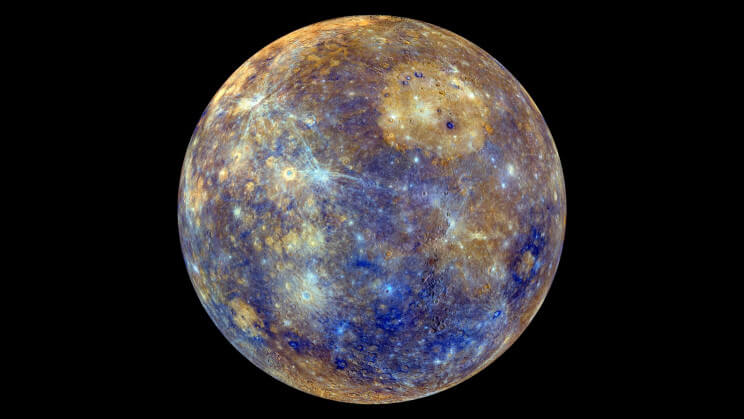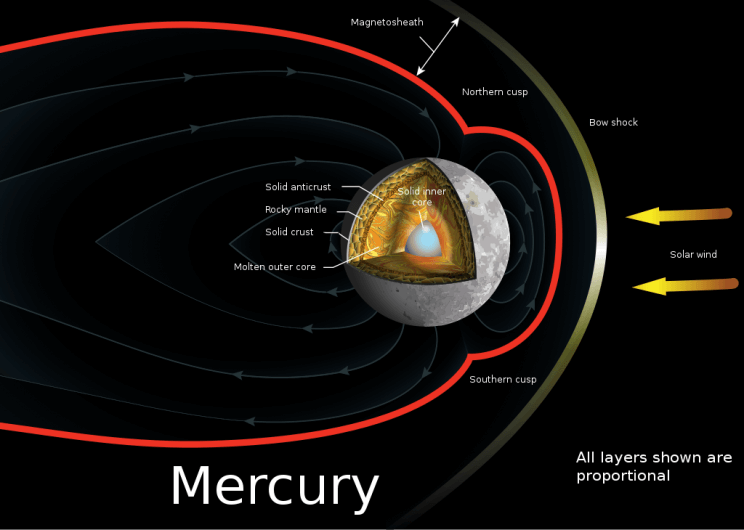The very idea of living and working on Mercury may seem unrealistic, like a plot from science fiction. However
For example, the local economy can be built onthe basis of "adventure tourism", as well as mining and energy. Mercury has a lot of ore and precious metals, and its proximity to the Sun provides it with a huge amount of stellar energy.
However, before building an economy, you need to understand how to live in this hostile environment. Here's what can get in the way.
Extreme temperatures
Despite the fact that Mercury is the closestto the Sun, this is not the hottest planet (this title belongs to Venus). The thing is that it almost never had and does not have an atmosphere, with the exception of a thin exosphere. It consists of atomic oxygen and hydrogen, sodium, magnesium, helium and other minerals in tiny amounts. However, the pressure on the planet does not exceed 5 x 10-15 bar (0.005 picobar). For comparison, this is one trillionth of the Earth's atmospheric pressure (altitude - sea level). Because of this, Mercury does not retain heat from the Sun and suffers from sudden changes in temperature. What does it look like?

The side facing the sun is heating upup to 427 ° C, and "night" is cooled down to –173 ° C. However, because of the orbit, these day and night extremes last for months! By the way, about the orbit. She is one of the most eccentric in the solar system. Due to its elliptical shape, the distance to the star ranges from 46 million km at perihelion to 70 million km at aphelion.
Really long days
Closeness to the Sun leads to a long periodcirculation of the planet. As a result, the year on Mercury passes very quickly. It lasts 88 Earth days - during this time the planet manages to go through one circle in its orbit around the Sun. Moreover, a day lasts 58 earth days.
Due to its proximity to the Sun, Mercury receivesvery intense radiation. This means that even if people figure out how to protect themselves from extreme temperatures, the effects of daylight on Mercury will be simply fatal. The settlers will have to constantly stay away from the sun. On this score, scientists have several ideas.
How to survive on Mercury?
If people hope to someday live on Mercury, they will have to figure out how to escape the Sun. The nature of the planet's structure and orbit gives future colonizers a chance.
- Life underground
Based on observations and data obtained by the probeMErcury Surface, Space Environment, GEochemistry and Ranging (MESSENGER), scientists realized that Mercury, like the Moon, has lava tubes. These are remnants of the planet's geologically active past. Some of them are large enough to accommodate an entire city.

Inside them, you can maintain a stable, and,most importantly, the optimal temperature for a comfortable stay (22 ± 1 ° C). Also, lava tubes can protect settlers from radiation. Given the lack of atmosphere, this will be very helpful. By the way, underground, in hermetically sealed conditions, it is possible to create an artificial earth-like atmosphere with a mixture of nitrogen and oxygen in a ratio of 78: 22.
- Life in motion
Another option is to create mobile settlements,which will constantly move west and keep on the border between day and night. Since Mercury's slow rotation and fast orbit results in 176 days of continuous daylight on one side of the planet, settlements do not need to move quickly.
- Life in a crater
Alternatively, a settlement can be establishedin permanently shaded areas such as the cratered north pole of Mercury. There temperatures are low enough for water ice to exist. The largest craters - Prokofiev, Chesterton, Kandinsky and Tryggvadottir - are large, from 31 km to 112 km. This is enough for a small town and even a metropolis.

In addition, the data obtained by the MESSENGER probeshowed that craters in this area can contain between 110 billion and 1.1 trillion tons of water ice. It could be harvested to meet the water needs of the colonists, and solar panels located at the edge of the crater would provide a constant source of energy. By the way, sunlight can penetrate the craters with the help of mirrors, which means that agriculture is theoretically possible.
Using the concept of paraterraforming,described by the British mathematician Richard Taylor in 1992, it is possible to make an airtight space inside the craters to create an artificial closed atmosphere.
So why master Mercury?
Mercury receives 6.5 times more than the sunenergy than the Earth. Using a group of solar satellites, it can be used not only to provide life for colonists. Engineers are now exploring space-based solar energy as a solution to climate change.
Constellation of satellites in orbit around Mercurycan collect huge amounts of solar energy. It could then be directed into the Earth-Moon system and elsewhere using microwave lasers. Mercury can be viewed as the "powerhouse" of the solar system.

Mercury is incredibly rich in precious metals andminerals. Like other rocky planets (Venus, Earth, and Mars), it is composed of silicate minerals and metals, divided into a silicate mantle and a crust surrounding a metal core (composed primarily of an iron-nickel alloy).
Based on the latest data, geologistscalculated that the crust and mantle are 35 km 600 km thick respectively, while the diameter of the core is estimated at 4,148 km. This means that the central region of the planet is 85% of the planet's size. The surface is rich in magnesium and sulfur, and there are also large caches of minerals and precious metals that asteroids and meteors have delivered to the planet throughout the history of the solar system.

Another plus of Mercury is its gravity.Despite the fact that it is the smallest planet in the solar system and even smaller than some moons (for example, the moon of Jupiter Ganymede), the gravity on its surface is close to that of Martian - 38% of the earth. Decades of research (in particular, the Twins Study) have shown that microgravity is bad for the human body - it loses muscle mass and bone density, vision, blood circulation, cardiovascular system and organ function are impaired. Less gravity would also make it relatively cheap to launch payloads or spacecraft from the surface.
Mercury is one of the candidates forcolonization within the solar system along with Mars, Venus, Moon, Ceres, Europa, Ganymede, Callisto, Titan. Perhaps future generations can call it their home.
Read more
Impossible to imagine: what are the largest objects in the universe and where they are
Look at pictures of two merging galaxies, taken 9 years apart
Elon Musk: Starship can lift 1,000 times more cargo than other rockets
Stephen L. Gillett... Mining the Moon. Analog